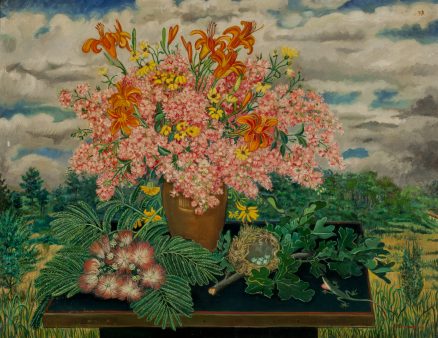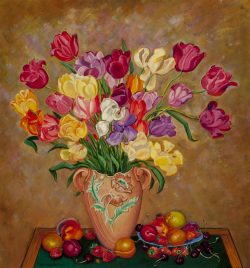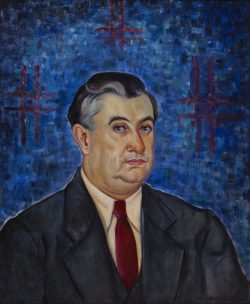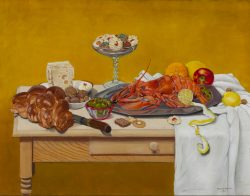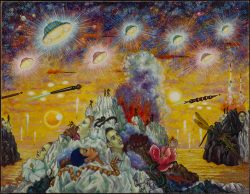Untitled (Floral Bouquet with Landscape)
, circa 1930sOil on canvas, 28 by 36 inches
- Categories
- Landscapes
- Still lifes
- Women artists
- Zoom in on Artwork
- Print Page
- Email Page to Friend
A riot of contrasting colors and forms, Macena Barton’s untitled painting is an unusual combination of still life and landscape imagery. A brown ceramic vase is overloaded with a rich combination of flowers, included spiky orange tiger lilies, yellow black-eyed susans, and clustered pink blossoms that may be a pink-tinted variety of lilac. The table bears mimosa blossoms and leaves on one side and on the other an oak branch bearing a bird’s nest containing several blue speckled eggs. Apparently approaching the nest is a green anole lizard with its characteristic red dewlap. The background for this incongruous display of natural specimens is a verdant landscape under a partly clouded sky that at the far right hints at a coming storm. The mimosa, the lizard, and the charged energy of the natural abundance evoke a subtropical world.
As in other Barton still-life paintings, such as Untitled (Still Life with Flowers in a Vase), objects and landscape background are evenly illuminated, with no shadows. Garish color and undifferentiating attention to detail further the sense of deliberate artificiality. Allegory or moral storytelling has long been a function of still-life painting. The oak leaves seen here, for example, traditionally symbolize strength, while birds’ eggs suggest hope and promise, perhaps threatened by the lizard (although in fact green anoles do not eat birds’ eggs). Barton’s image goes beyond direct communication through established symbols, however, to conjure a subtle strangeness. As if to emphasize that the table actually inhabits the outdoor world seen behind it, the tips of grasses overlap its front edge, yet this only confuses the viewer’s perception of the spatial relationship between close-up objects and the distant landscape. On that table edge, a series of small black spots can be read as the nails attaching a canvas to the edge of a stretcher, as if the tabletop is itself a painting, albeit one simply painted black with a red border. Finally, and most intriguingly, Barton signed the work in red at lower right with a deliberate misspelling of her first name—Macina rather than Macena. Encoded with highly personal if cryptic messages, this combined still life and landscape may serve as a kind of self-portrait for an artist who painted herself obsessively throughout her career.
Wendy Greenhouse, PhD
Donated by M. Christine Schwartz to the Newberry Library, Chicago, Illinois, in 2021
